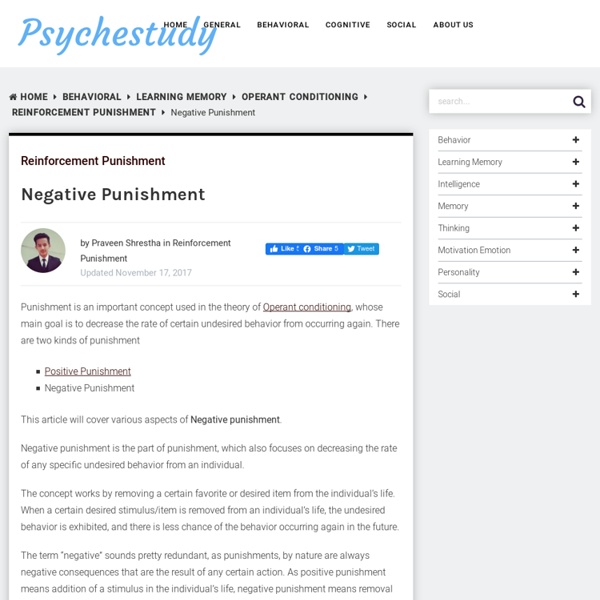How Negative Punishment Works
Negative punishment is an important concept in B. F. Skinner's theory of operant conditioning.
Teen Bad Behavior & Discipline Plans - Promoting Healthy Growth Ages 15 - 18
Bad behavior doesn't end when your child graduates from diapers -- or even from middle school. In fact, the teen years can bring some of the toughest discipline challenges parents have to face. Sulking, arguing, lying, and rebelling are just a few of the ways teens misbehave.
Article 2
Positive punishment is a concept used in B.F. Skinner's theory of operant conditioning. How exactly does the positive punishment process work? The goal of any type of punishment is to decrease the behavior that it follows. In the case of positive punishment, it involves presenting an unfavorable outcome or event following an undesirable behavior. When the subject performs an unwanted action, some type of negative outcome is purposefully applied.
Positive Punishment
Punishment is a fundamental concept used in the theory of Operant conditioning. The main objective of a punishment is to decrease the rate of certain undesired behavior from occurring again. Among the two kinds of punishment, Positive and Negative, we are going to discuss Positive punishment in this article. Positive punishment is the part of punishment, which also focuses on decreasing the rate of any specific undesired behavior from an individual. The concept works by presenting a certain negative consequence to the individual once an undesired behavior has been exhibited.
How to Reward Your Teen for Good Behavior
Teenagers are young adults who are trying to learn the ways of the world. When they do something great at school or at home or simply make a healthy decision, parents can give them a reward. The reward does not have to be money, but it is a nice way to say "thank you" or "I'm proud of you." Teens need this positive reinforcement because it shows them that they are on the right track.1 It is also a good life lesson that you can pass on: good things happen to good people.
Article 1
“Positive” and “punishment” seem like two words that you wouldn’t use together. However, positive punishment will make complete sense once you learn the definition and explore some examples of positive punishment. Review how positive punishment is different from negative punishment and which is more effective.
Positive Reinforcement: Changing The Behavior of Children For The Better
Home » Positive Education » Positive Reinforcement: Changing The Behavior of Children For The Better “The way positive reinforcement is carried out is more important than the amount.”– B.F. Skinner The purpose of reinforcement is to help increase the probability that a specific behavior will occur when a stimulus is delivered after a response is shown. When people think of reinforcement they immediately think of Pavlov, or at least I do.
Negative Reinforcement and Operant Conditioning
Negative reinforcement is a term described by B. F. Skinner in his theory of operant conditioning. In negative reinforcement, a response or behavior is strengthened by stopping, removing, or avoiding a negative outcome or aversive stimulus.1 Overview Aversive stimuli tend to involve some type of discomfort, either physical or psychological.
Article 1
Reinforcement is a fundamental concept of Operant Conditioning, whose major objective is to increase the rate of certain undesired behavior from occurring again. Reinforcement can be further classified into two major parts The major purpose of both these reinforcement types is to increase the rate of certain behavior although they have many similarities and differences. By introducing the concept of reinforcement to an individual, the individual gets encouraged to perform the behavior in a repeated manner whether to avoid any undesirable stimulusreceive the desirable reinforcer or reward again Differences Between Positive and Negative Reinforcement
4 Negative Reinforcement Examples
Contrary to its name, negative reinforcement isn't a bad thing. Rather than introducing something negative to deter bad behaviour (otherwise known as punishment), this theory of parenting removes something negative to encourage good behaviour. It's easier to understand when you see some negative reinforcement examples. Looking for a babysitter? Find sitters in your area now. What is negative reinforcement?



